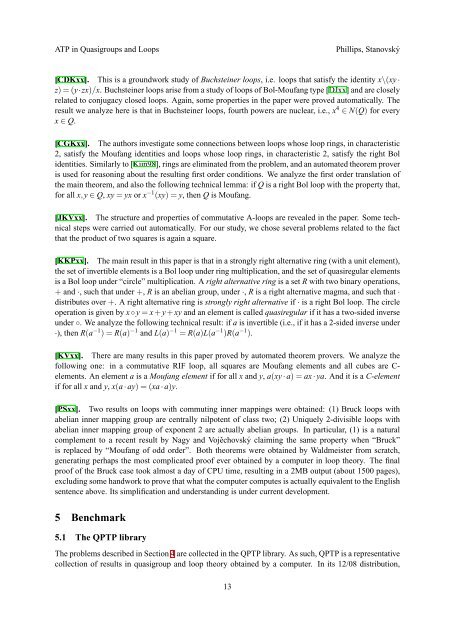Automated Theorem Proving in Quasigroup and Loop Theory
Automated Theorem Proving in Quasigroup and Loop Theory
Automated Theorem Proving in Quasigroup and Loop Theory
Create successful ePaper yourself
Turn your PDF publications into a flip-book with our unique Google optimized e-Paper software.
ATP <strong>in</strong> <strong>Quasigroup</strong>s <strong>and</strong> <strong>Loop</strong>s<br />
Phillips, Stanovský<br />
[CDKxx]. This is a groundwork study of Buchste<strong>in</strong>er loops, i.e. loops that satisfy the identity x\(xy ·<br />
z) = (y·zx)/x. Buchste<strong>in</strong>er loops arise from a study of loops of Bol-Moufang type [DJxx] <strong>and</strong> are closely<br />
related to conjugacy closed loops. Aga<strong>in</strong>, some properties <strong>in</strong> the paper were proved automatically. The<br />
result we analyze here is that <strong>in</strong> Buchste<strong>in</strong>er loops, fourth powers are nuclear, i.e., x 4 ∈ N(Q) for every<br />
x ∈ Q.<br />
[CGKxx]. The authors <strong>in</strong>vestigate some connections between loops whose loop r<strong>in</strong>gs, <strong>in</strong> characteristic<br />
2, satisfy the Moufang identities <strong>and</strong> loops whose loop r<strong>in</strong>gs, <strong>in</strong> characteristic 2, satisfy the right Bol<br />
identities. Similarly to [Kun98], r<strong>in</strong>gs are elim<strong>in</strong>ated from the problem, <strong>and</strong> an automated theorem prover<br />
is used for reason<strong>in</strong>g about the result<strong>in</strong>g first order conditions. We analyze the first order translation of<br />
the ma<strong>in</strong> theorem, <strong>and</strong> also the follow<strong>in</strong>g technical lemma: if Q is a right Bol loop with the property that,<br />
for all x,y ∈ Q, xy = yx or x −1 (xy) = y, then Q is Moufang.<br />
[JKVxx]. The structure <strong>and</strong> properties of commutative A-loops are revealed <strong>in</strong> the paper. Some technical<br />
steps were carried out automatically. For our study, we chose several problems related to the fact<br />
that the product of two squares is aga<strong>in</strong> a square.<br />
[KKPxx]. The ma<strong>in</strong> result <strong>in</strong> this paper is that <strong>in</strong> a strongly right alternative r<strong>in</strong>g (with a unit element),<br />
the set of <strong>in</strong>vertible elements is a Bol loop under r<strong>in</strong>g multiplication, <strong>and</strong> the set of quasiregular elements<br />
is a Bol loop under “circle” multiplication. A right alternative r<strong>in</strong>g is a set R with two b<strong>in</strong>ary operations,<br />
+ <strong>and</strong> ·, such that under +, R is an abelian group, under ·, R is a right alternative magma, <strong>and</strong> such that ·<br />
distributes over +. A right alternative r<strong>in</strong>g is strongly right alternative if · is a right Bol loop. The circle<br />
operation is given by x ◦ y = x + y + xy <strong>and</strong> an element is called quasiregular if it has a two-sided <strong>in</strong>verse<br />
under ◦. We analyze the follow<strong>in</strong>g technical result: if a is <strong>in</strong>vertible (i.e., if it has a 2-sided <strong>in</strong>verse under<br />
·), then R(a −1 ) = R(a) −1 <strong>and</strong> L(a) −1 = R(a)L(a −1 )R(a −1 ).<br />
[KVxx]. There are many results <strong>in</strong> this paper proved by automated theorem provers. We analyze the<br />
follow<strong>in</strong>g one: <strong>in</strong> a commutative RIF loop, all squares are Moufang elements <strong>and</strong> all cubes are C-<br />
elements. An element a is a Moufang element if for all x <strong>and</strong> y, a(xy · a) = ax · ya. And it is a C-element<br />
if for all x <strong>and</strong> y, x(a · ay) = (xa · a)y.<br />
[PSxx]. Two results on loops with commut<strong>in</strong>g <strong>in</strong>ner mapp<strong>in</strong>gs were obta<strong>in</strong>ed: (1) Bruck loops with<br />
abelian <strong>in</strong>ner mapp<strong>in</strong>g group are centrally nilpotent of class two; (2) Uniquely 2-divisible loops with<br />
abelian <strong>in</strong>ner mapp<strong>in</strong>g group of exponent 2 are actually abelian groups. In particular, (1) is a natural<br />
complement to a recent result by Nagy <strong>and</strong> Vojěchovský claim<strong>in</strong>g the same property when “Bruck”<br />
is replaced by “Moufang of odd order”. Both theorems were obta<strong>in</strong>ed by Waldmeister from scratch,<br />
generat<strong>in</strong>g perhaps the most complicated proof ever obta<strong>in</strong>ed by a computer <strong>in</strong> loop theory. The f<strong>in</strong>al<br />
proof of the Bruck case took almost a day of CPU time, result<strong>in</strong>g <strong>in</strong> a 2MB output (about 1500 pages),<br />
exclud<strong>in</strong>g some h<strong>and</strong>work to prove that what the computer computes is actually equivalent to the English<br />
sentence above. Its simplification <strong>and</strong> underst<strong>and</strong><strong>in</strong>g is under current development.<br />
5 Benchmark<br />
5.1 The QPTP library<br />
The problems described <strong>in</strong> Section 4 are collected <strong>in</strong> the QPTP library. As such, QPTP is a representative<br />
collection of results <strong>in</strong> quasigroup <strong>and</strong> loop theory obta<strong>in</strong>ed by a computer. In its 12/08 distribution,<br />
13
















